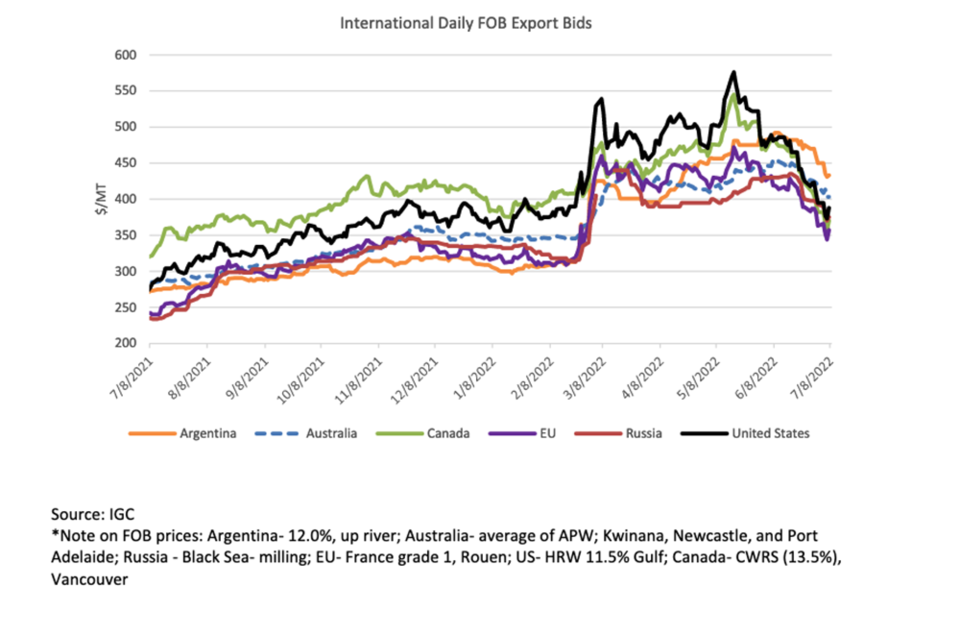WESTERN PRODUCER — Wheat prices plunged between the U.S. Department of Agriculture’s June and July World Agricultural Supply and Demand Estimates report. Canada led the way with a decline of $113 per tonne. However, MarketsFarm analyst Bruce Burnett doesn’t think that is a very reliable number because very little Canadian wheat traded during that time. Source: USDA, International Grains Council
The biggest surprise in the U.S. Department of Agriculture’s latest World Agricultural Supply and Demand Estimates report was its Canadian wheat production estimate, says an analyst.
“USDA is wildly optimistic at 34 million tonnes for Canada,” said MarketsFarm analyst Bruce Burnett.
That is one million tonnes higher than its June forecast and 57 percent higher than last year’s output.
Burnett doesn’t believe that number considering the conditions in Western Canada range from excessive moisture to parched land.
It is one of the latest crops ever planted in the eastern Prairies, while farmers wrestle with lingering drought in the west.
Heat warnings were being issued for western Saskatchewan and eastern Alberta at about the same time the USDA released its July WASDE report.
Burnett believes the crop will be closer to 30 million tonnes and may be even smaller if July remains hot and dry.
The other controversial estimate was the 81.5-million-tonne forecast for Russia’s wheat crop, up only slightly from the June number of 81 million tonnes.
Analysts had been expecting a much bigger upward adjustment. SovEcon is forecasting 89.2 million tonnes of production while other Black Sea analysts are generally in the 87 to 88-million-tonne range.
“I was surprised. I thought they would increase production by more than they did,” said Burnett. “The USDA is probably being somewhat conservative.”
Mark Simone, foodgrains analyst with the USDA’s World Agricultural Outlook Board, said the difference is that SovEcon and other private analysts estimate their wheat production using planted area rather than harvested area, which is what the USDA uses.
“USDA also counts the production in Crimea as part of Ukraine production rather than Russia as SovEcon and others do and this is around one million tonnes for wheat production,” he said in an email.
In a separate report, the USDA noted that global wheat prices tumbled dramatically between the June and July WASDE reports.
Canada led the way, with price quotes falling a whopping US$113 per tonne. That was nearly double the decline experienced in many other exporting nations.
European Union prices fell $62 per tonne, Russia’s wheat slid $55 per tonne, Australia dropped $51 per tonne and Argentina was down $59 per tonne.
The only major exporter with a decline anywhere close to Canada’s was the United States, where prices fell $95 per tonne.
Canadian wheat was quoted at $370 per tonne as of July 8, making it the second cheapest wheat of all those major exporters except the European Union at $357 per tonne.
Burnett doesn’t put much stock in those numbers primarily because little Canadian wheat was traded during that period due to dwindling supplies.
“It’s very hard to characterize a market when you don’t have hardly anything to sell,” he said. “The price drop is dramatic but it’s quite a slow period for us in terms of sales.”
He also noted the prices used by the USDA are a bit of an apples to oranges comparison.
For instance, it was comparing CWRS 14.5 percent protein wheat out of Vancouver with U.S. hard red winter wheat with 11.5 percent protein out of the Gulf of Mexico.
A more apt comparison would be dark northern spring wheat 14 percent protein out of the Pacific Northwest, said Burnett.

